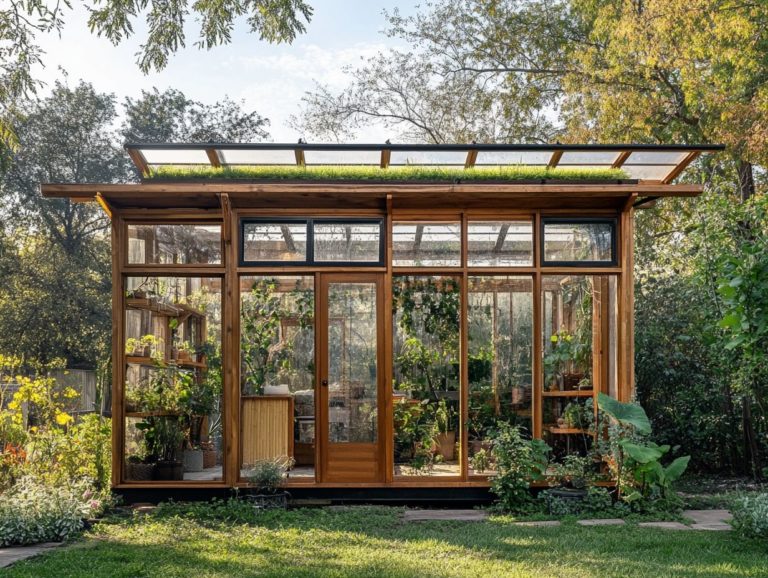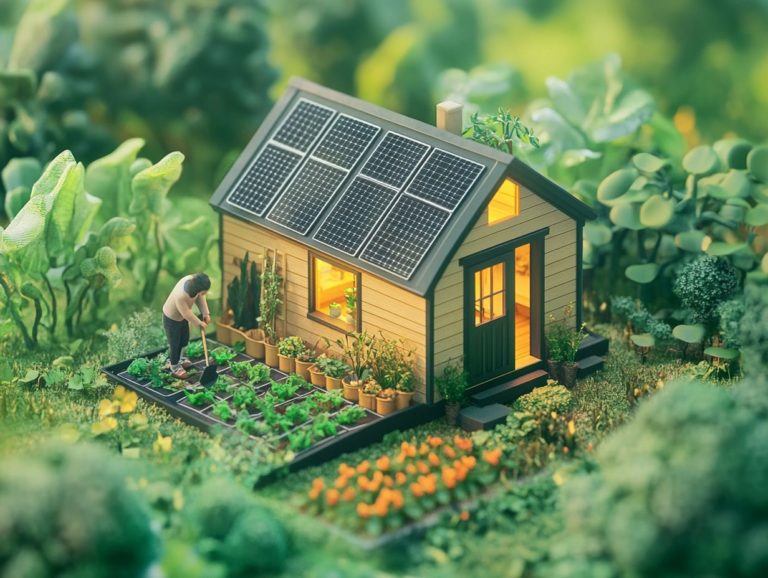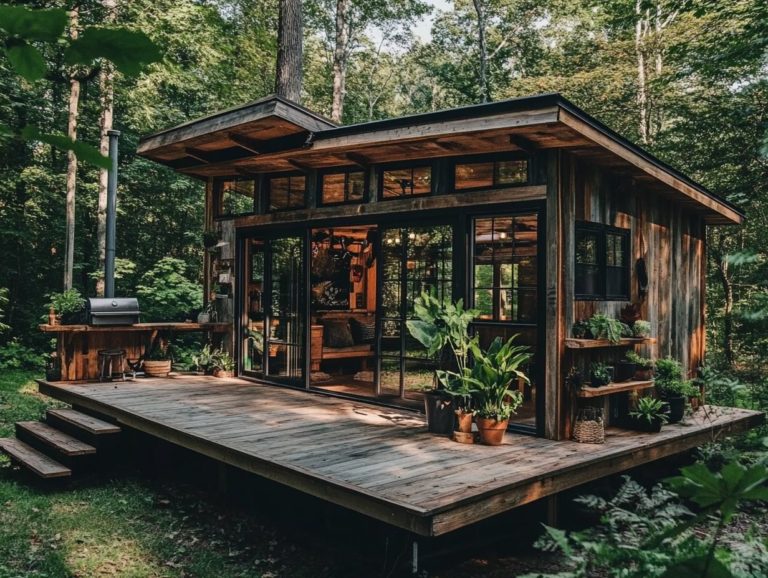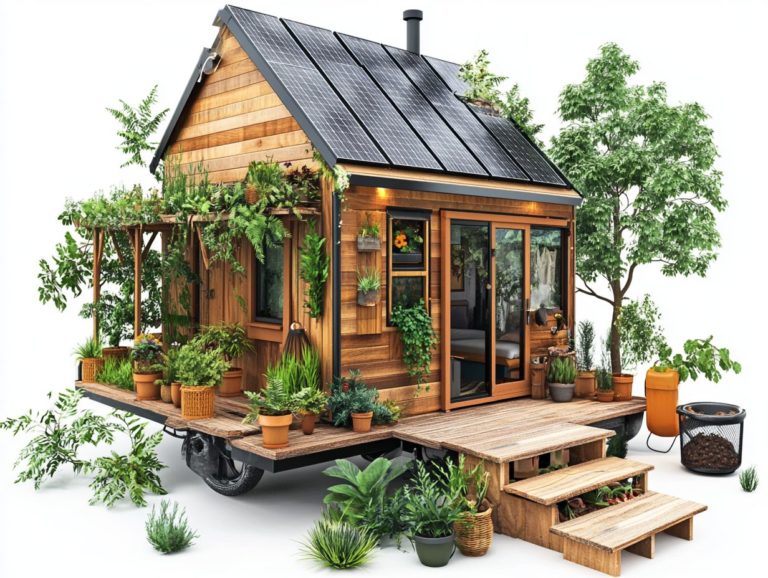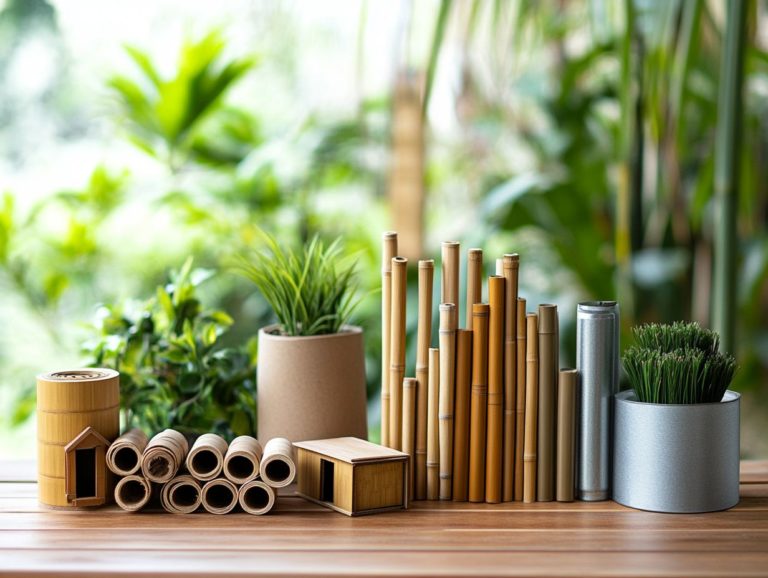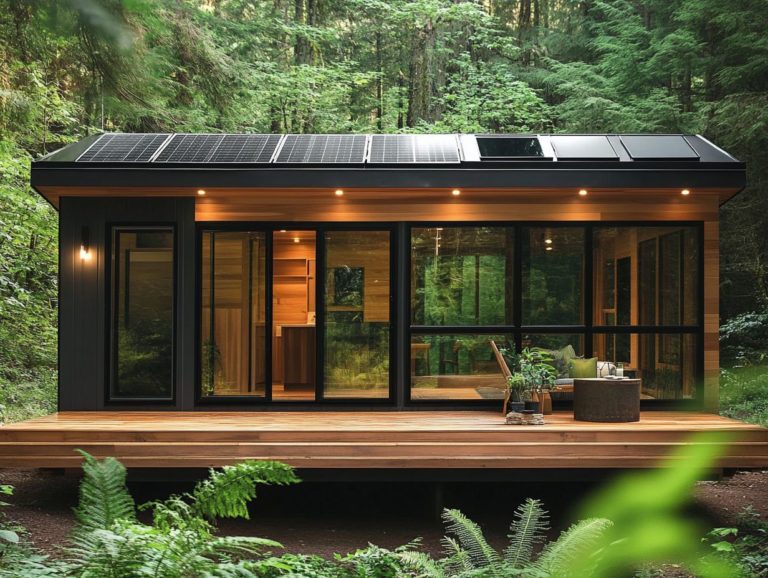5 Ways to Make Your Tiny House More Eco-Friendly
As the tiny house movement gains momentum, you are likely uncovering the remarkable environmental benefits that come with downsizing.
Discover five easy ways to make your tiny home greener! This article focuses on actionable strategies to elevate the eco-friendliness of your tiny home, from installing solar panels to selecting sustainable materials.
It highlights the perks of tiny living, offers insight into reducing your carbon footprint, addresses potential challenges, and outlines the long-term savings associated with eco-friendly decisions.
Don t miss the chance to live greener and happier in your tiny home today!
Contents [hide]
- Key Takeaways:
- 1. Install Solar Panels
- 2. Use Energy-Efficient Appliances
- 3. Incorporate Natural Light and Ventilation
- 4. Use Sustainable Building Materials
- 5. Implement a Rainwater Harvesting System
- Is Living in a Tiny House Really More Eco-Friendly?
- What Are the Benefits of Living in a Tiny House?
- How Can You Reduce Your Carbon Footprint in a Tiny House?
- What Are the Challenges of Making a Tiny House Eco-Friendly?
- How Can You Incorporate Sustainable Practices in Your Daily Life in a Tiny House?
- What Are the Long-Term Cost Savings of Living in an Eco-Friendly Tiny House?
- Frequently Asked Questions
- 1. What are five ways to make my tiny house more eco-friendly?
- 2. How can solar panels make my tiny house more eco-friendly?
- 3. What are some sustainable materials that can be used in a tiny house?
- 4. What are the benefits of using energy-efficient appliances in a tiny house?
- 5. How can natural ventilation make my tiny house more eco-friendly?
- 6. How can I reduce water consumption in my tiny house?
Key Takeaways:
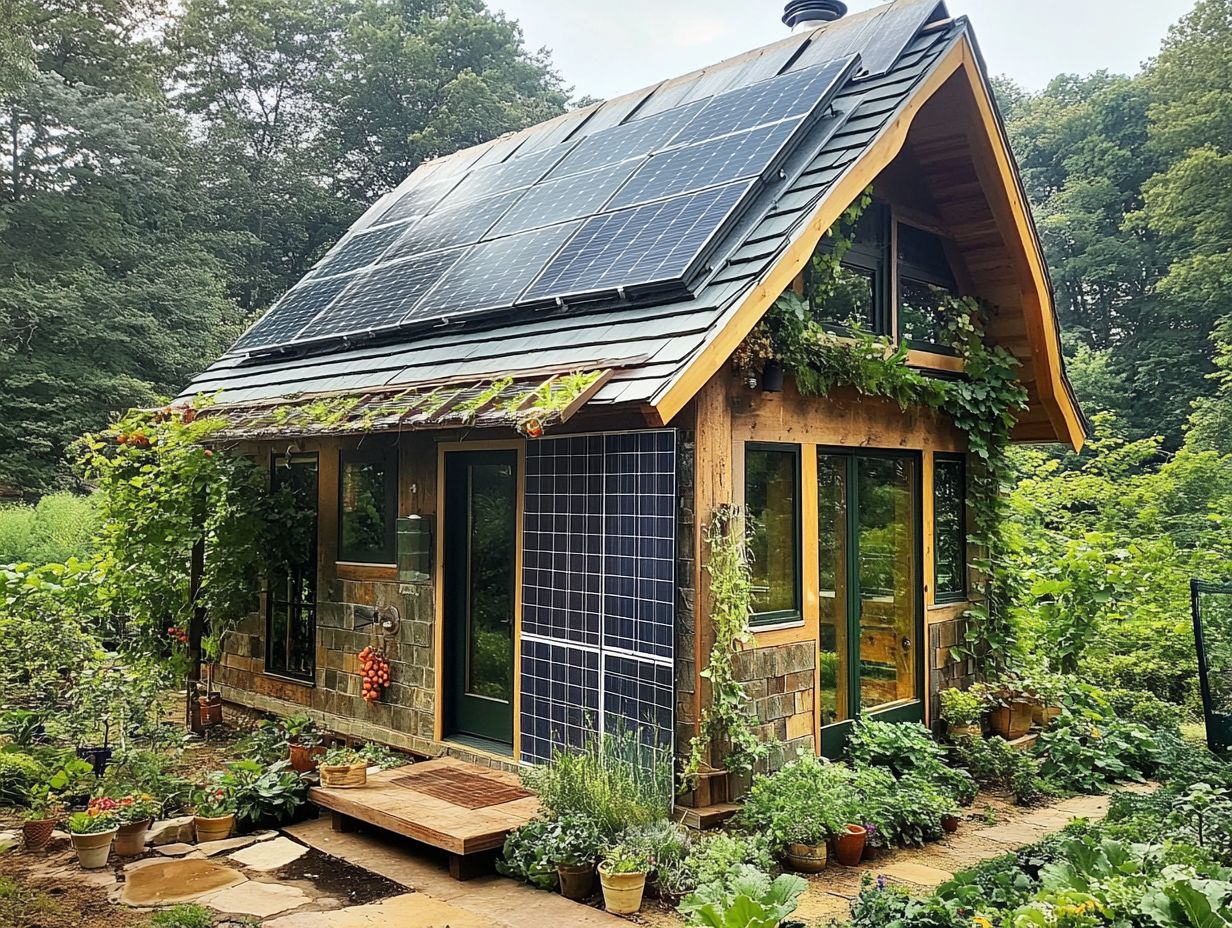
- Install solar panels and say goodbye to high energy bills!
- Use energy-efficient appliances to save energy and cut down costs.
- Incorporate natural light and ventilation for a healthier living space.
1. Install Solar Panels
Installing solar panels is one of the best ways to embrace eco-friendly living in a tiny home. This renewable energy source significantly reduces your carbon footprint while promoting energy efficiency and offering long-term cost savings.
Imagine harnessing the sun’s abundant energy to power your home, leading to substantial monthly savings on your utility bills. Various types of solar panels monocrystalline, polycrystalline, and thin-film each provide unique benefits tailored to your specific energy needs and space constraints.
You can choose a DIY installation or hire professionals, which can impact both the performance and longevity of your system. Integrating solar panels with other eco-friendly technologies such as energy-efficient appliances and greywater recycling systems systems that reuse water from sinks and showers enhances your sustainability efforts.
This creates a harmonious ecosystem that maximizes resource use while minimizing waste, making your tiny home truly eco-conscious.
2. Use Energy-Efficient Appliances
Utilizing energy-efficient appliances in your tiny home does more than lower energy consumption; it significantly reduces your overall environmental impact while leading to impressive cost savings over time.
These advanced appliances minimize energy waste, allowing you to enjoy the same level of comfort and convenience as traditional models without compromising efficiency. From refrigerators that use eco-friendly refrigerants to washing machines that consume less water and electricity, today s options cater to various needs.
By choosing appliances with high energy ratings, you contribute to a healthier planet and benefit from lower utility bills. Investing in such equipment is essential for anyone looking to cultivate a truly sustainable lifestyle in compact living spaces.
3. Incorporate Natural Light and Ventilation
Incorporating natural light and effective ventilation systems into your tiny home design elevates indoor air quality and fosters a healthier living environment that embraces the principles of eco-friendly living.
Strategically placing elements like skylights and large windows maximizes sunlight exposure, transforming even the coziest spaces into open, inviting havens. This influx of light creates a positive atmosphere, enhancing your mood and productivity.
Proper ventilation ensures that fresh air flows freely throughout your home, minimizing reliance on artificial systems. When paired with indoor plants that naturally purify the air and multi-functional furniture that optimizes space, these design choices create a harmonious living environment prioritizing your well-being and environmental mindfulness.
4. Use Sustainable Building Materials
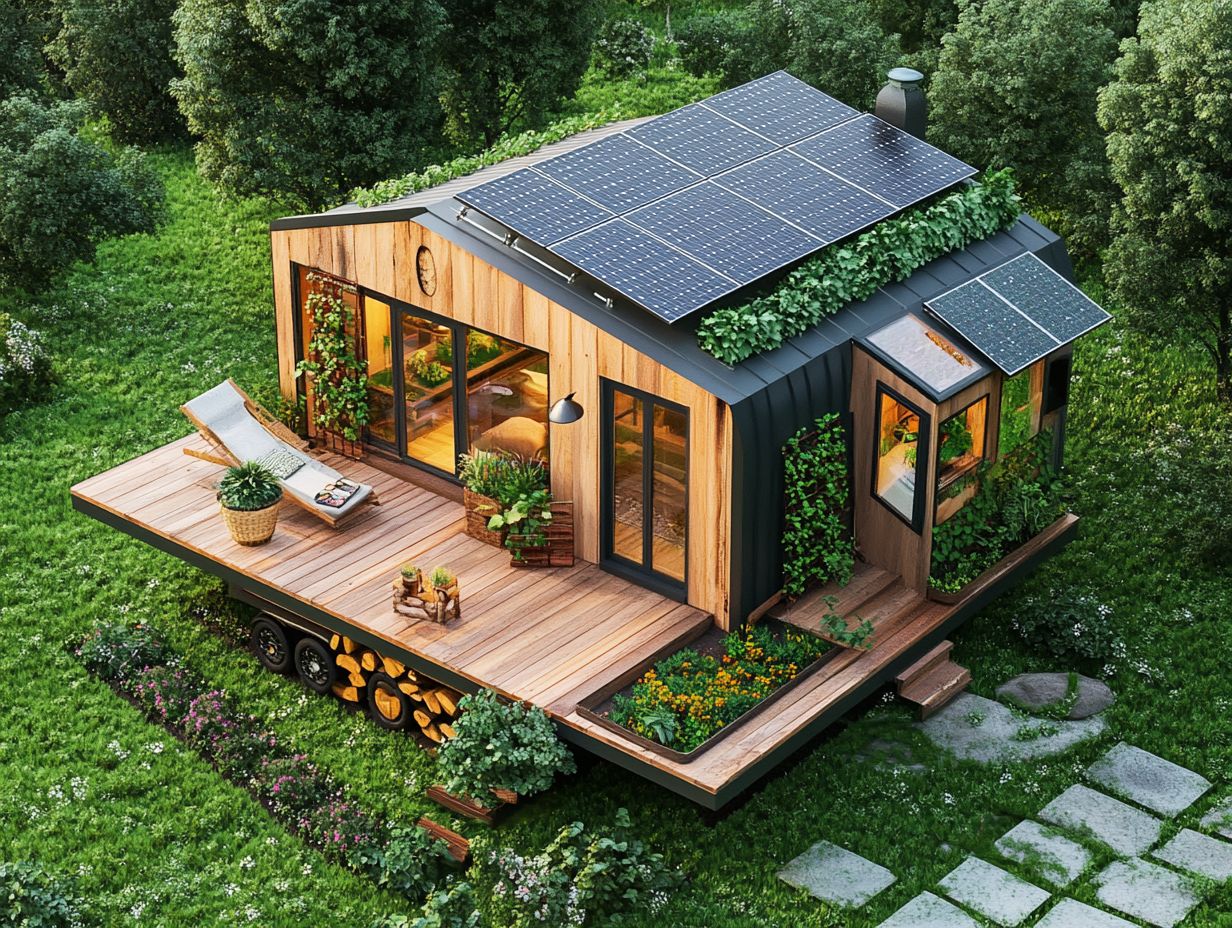
Choosing sustainable building materials, like reclaimed wood and bamboo flooring, is essential for minimizing your tiny home’s environmental footprint. These materials ensure durability and aesthetic appeal.
Eco-friendly materials not only elevate the charm of your living space but also enhance energy efficiency. For instance, using cork and hemp insulation can significantly reduce energy consumption, leading to lower utility bills over time.
Selecting low-maintenance options means fewer repairs or replacements, resulting in less waste and a more efficient use of resources in the long run. By prioritizing these sustainable choices, you contribute to a meaningful reduction in the ecological footprint of the building process, promoting a healthier planet for generations to come.
5. Implement a Rainwater Harvesting System
Implementing a rainwater harvesting system is a vital step toward effective water conservation in your tiny home. This approach allows you to harness natural resources and reduces reliance on city water, promoting a lifestyle rooted in sustainability.
This system comprises various components, including gutters, storage tanks, and filtration units. Each part is designed to capture and store rainwater for your future use. You can seamlessly integrate these elements into your existing structures, ensuring harmony with greywater recycling systems that redirect household wastewater for non-potable purposes.
Opting for low-flow fixtures in your sinks and showers amplifies the advantages of these systems, significantly minimizing your water consumption during everyday activities. You ll love how these strategies can slash your water bills while actively contributing to environmental sustainability.
Is Living in a Tiny House Really More Eco-Friendly?
Living in a tiny house makes a compelling case for eco-friendliness, embodying the principles of minimalism and sustainable living. It significantly reduces your environmental impact and the resources you need for daily life.
This lifestyle minimizes your energy consumption by requiring less heating and cooling. It also fosters a deep connection with nature and encourages a mindful approach to resource management. Unlike traditional living spaces that encourage excess, tiny homes inspire sustainability and prompt you to personalize your tiny house design to reduce waste and choose eco-friendly materials.
By embracing a simpler way of living, you can make choices that align with a greener lifestyle. This ultimately leads to a smaller carbon footprint and a stronger sense of community through shared values.
What Are the Benefits of Living in a Tiny House?
Choosing to live in a tiny house brings a wealth of advantages, such as being mortgage-free and embracing a cost-effective lifestyle. This not only grants you financial freedom but also encourages a simpler, more intentional existence that aligns with sustainable living practices.
By downsizing to a smaller space, you’ll likely see significant savings on utilities and maintenance costs. This allows you to allocate resources toward experiences instead of accumulating possessions. To enhance this lifestyle, consider 7 ways to create a multi-functional tiny home. This choice naturally minimizes your environmental footprint, as tiny homes generally require fewer materials and less energy to sustain.
Embracing minimalism can transform your quality of life, allowing you to prioritize relationships and experiences over material goods. Ultimately, this shift leads to greater happiness and satisfaction.
How Can You Reduce Your Carbon Footprint in a Tiny House?
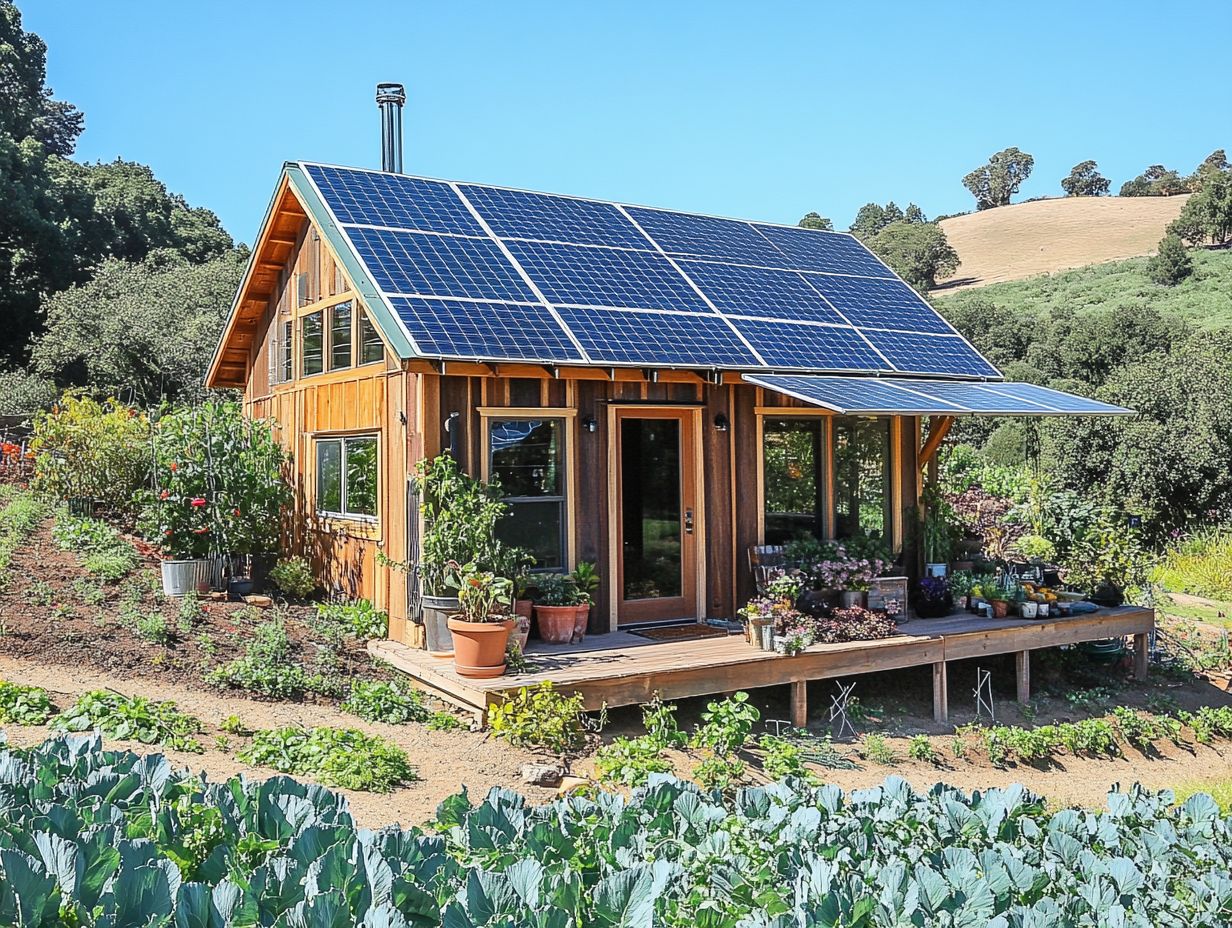
Reducing your carbon footprint in a tiny house is within your reach. You can do this through various thoughtful approaches, like incorporating eco-friendly upgrades and maximizing energy efficiency.
Focus on practical strategies. Use energy-efficient appliances, install solar panels, and adopt water conservation techniques like greywater recycling using wastewater from sinks and showers for irrigation. For more insights, consider designing a tiny house for sustainability to further reduce your environmental impact.
Transitioning to LED lighting and smart thermostats improves energy management. Using rainwater harvesting systems supports sustainable water levels.
Each of these changes promotes a sustainable lifestyle and inspires others to adopt similar practices.
What Are the Challenges of Making a Tiny House Eco-Friendly?
Embracing eco-friendly practices in your tiny house comes with rewards but also presents challenges worth considering. Sourcing durable materials and effectively integrating sustainable practices within a compact space can be quite challenging.
In tiny living, space constraints often hinder the inclusion of traditional eco-friendly solutions, such as large solar panels or big gardens. However, there are 5 ways to reflect your personality in a tiny house that can help you incorporate unique and sustainable elements. Finding sustainably sourced materials can be a significant obstacle, especially in areas where eco-friendly options are very expensive.
To navigate these challenges, explore alternative solutions like multi-functional furniture that serves several purposes. This maximizes your space and enhances functionality.
Partnering with local suppliers who prioritize sustainable practices can provide access to better materials, allowing for a more environmentally responsible approach to your tiny living journey.
How Can You Incorporate Sustainable Practices in Your Daily Life in a Tiny House?
Incorporating sustainable practices into your daily life in a tiny house is rewarding and completely doable! Imagine options like upcycling, utilizing composting toilets, and engaging in water conservation efforts that elevate your eco-friendly lifestyle.
Start by repurposing old furniture or materials into functional items. This reduces waste and adds a personal touch to your home. Additionally, exploring sustainable design practices for tiny houses can enhance your efforts. Transitioning to composting toilets conserves water while enriching the soil for gardening.
When selecting building materials, choose recycled or sustainably sourced options to minimize your environmental footprint. Optimize daily energy consumption by using energy-efficient appliances and harnessing solar power whenever possible.
Even simple choices, like opting for natural cleaners and cutting back on single-use plastics, will enhance your eco-conscious daily routine.
What Are the Long-Term Cost Savings of Living in an Eco-Friendly Tiny House?
The long-term cost savings of living in an eco-friendly tiny house are impressive. By choosing energy-efficient appliances and sustainable building materials, you can significantly lower your utility bills and reduce maintenance costs over time.
Embracing eco-friendly practices encourages a mindful approach to resource usage, often leading to decreased consumption and additional savings. Many eco-conscious homeowners find that investing in renewable energy sources, like solar panels, cuts energy costs and may unlock potential tax incentives, making that initial investment more manageable.
The durability of sustainable materials means fewer repairs and replacements, cultivating a sense of financial stability.
As you prioritize sustainability, you may discover that greener choices often translate into lasting economic benefits, creating a win-win for both your wallet and the planet.
Watch this inspiring video to see how easy it is to make your tiny house eco-friendly! Start making these eco-friendly changes today!
Frequently Asked Questions
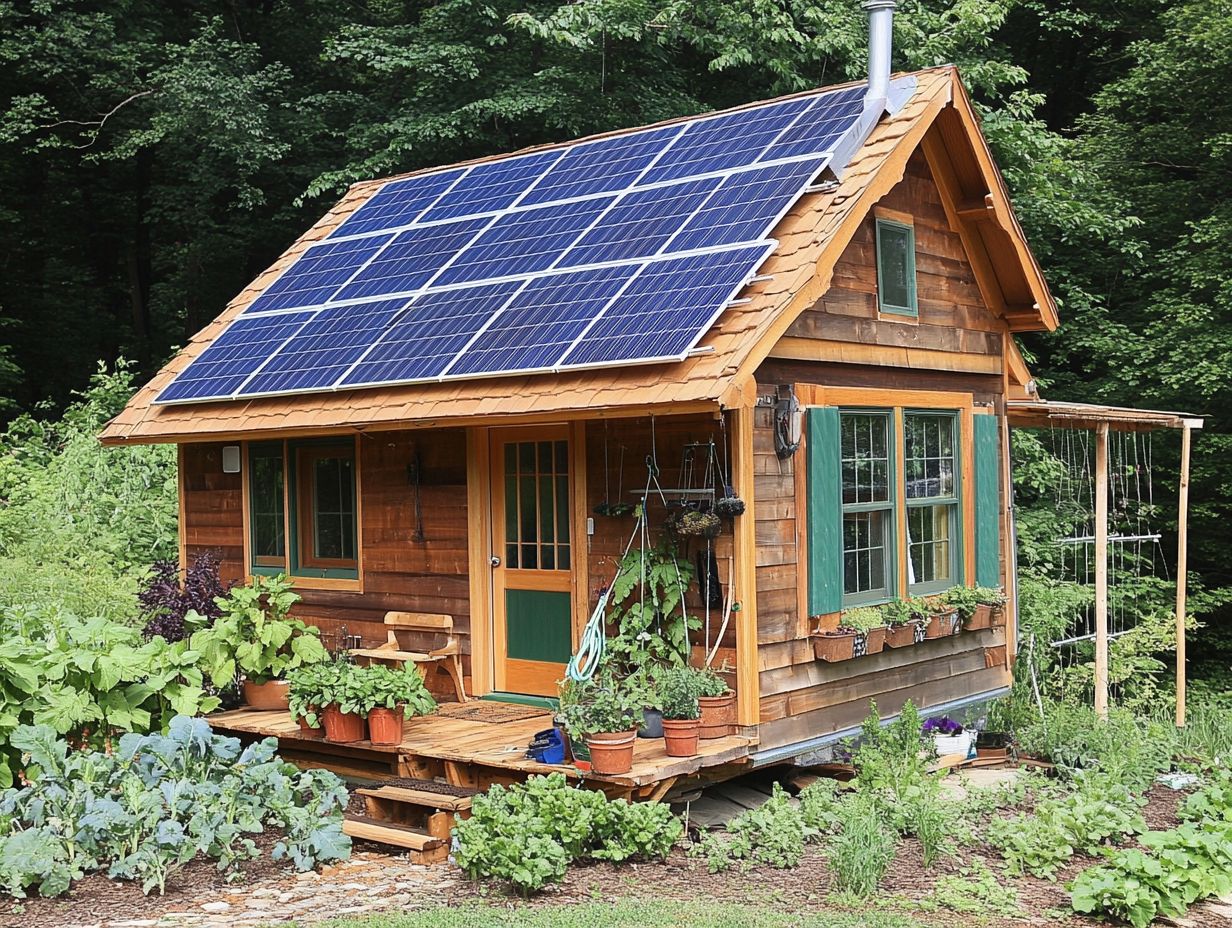
1. What are five ways to make my tiny house more eco-friendly?
You can make your tiny house eco-friendly by installing solar panels, using sustainable materials, implementing energy-efficient appliances, incorporating natural ventilation, and reducing water consumption.
2. How can solar panels make my tiny house more eco-friendly?
Solar panels reduce your reliance on traditional electricity sources. This decreases your carbon footprint and saves you money on energy bills. They also last a long time and need minimal maintenance.
3. What are some sustainable materials that can be used in a tiny house?
Sustainable materials for tiny houses include bamboo, reclaimed wood, recycled metal, and natural insulation like wool or cork. These materials are eco-friendly and add unique character to your tiny house.
4. What are the benefits of using energy-efficient appliances in a tiny house?
Energy-efficient appliances, such as LED light bulbs and low-flow water fixtures, significantly cut down on your energy and water usage. This helps the environment and saves you money over time.
5. How can natural ventilation make my tiny house more eco-friendly?
Use natural ventilation by adding windows and skylights. This can lessen the need for air conditioning and artificial lighting, saving energy and promoting healthier indoor air quality.
6. How can I reduce water consumption in my tiny house?
You can lower water use in your tiny house by installing low-flow fixtures, collecting rainwater for non-drinking purposes, and being mindful of your habits. Conserving water benefits the environment and helps you save on water bills.

